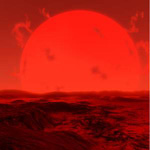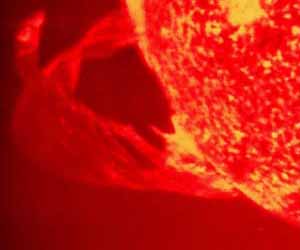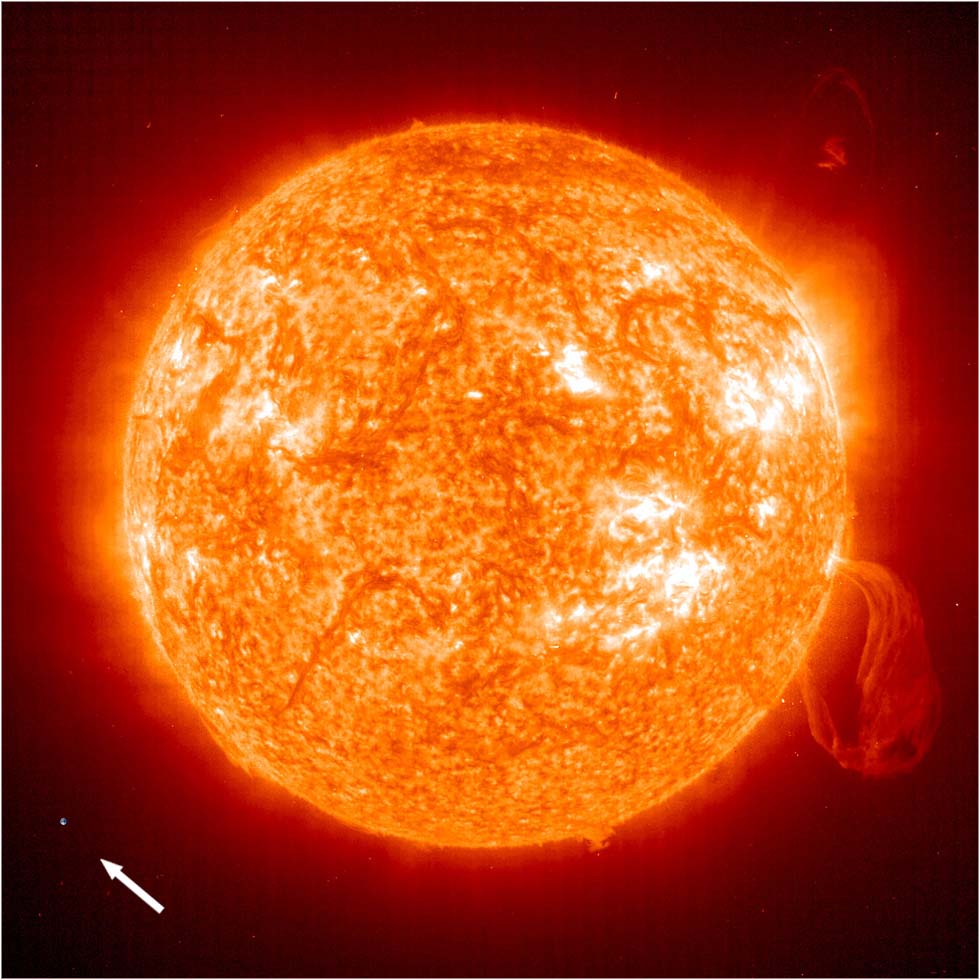|
Our Sun
|
Orbit
Jupiter travels once around the Sun every 12 years and spins on its own axis every 10 hours compared to 24 on Earth, making it the fastest spinning planet in the Solar System.
Atmosphere
The atmosphere of Jupiter is composed of about 86 percent hydrogen, 14 percent helium, and tiny amounts of methane, ammonia, phosphine, water, acetylene, ethane, germanium, and carbon monoxide.
Temperature
The temperature at the top of Jupiter's clouds is about -145C (-230F). Deeper below the clouds the temperate reaches 21C (70F). Near the planet's centre the temperature is hotter than the surface of the Sun!
Planet Jupiter Statistics
Diameter: 89,000 miles (143,000 km)Average Distance from Sun: 484 million miles (779 million km)
Orbital Period: 12 years
Rotation Period: 9.93 hours
Moons: 63
Maximium Temperatures: 24,000C (43,000F) (Core)
Minumum Temperatures: -145C (-230F) (Cloud Tops)
Gravity: 20.87 m/s2 (2.14 x Earth's Gravity)
Density: 1.33 g/cm3 (24% Earth's Density)
Mass: 1.8987 x 1027 kg (318 x Earth's Mass)
Volume: 1.4255 x 1015 km3 (1316 x Earth's Volume) Atmosphere: 86% Hydrogen, 14% Helium, 0.3% Methane, 0.026% Ammonia, 0.003% Hydrogen deuteride, 0.0006% Ethane, 0.0004% water.
| Life of Our Sun |

| Our Nearest Neighbours |

| The Sun - Images and Videos |
Solar flare


Sun Rotation (NASA)
Sun in our sky


|
The Sun - Vital Statistics
Comparison with Earth
|
Diameter: 864,000 miles (1.4 million km)
Distance from Centre of Galaxy: 25 million light years
Orbital Period: 250 million years
Rotation Period: 25.38 days
Maximium Temperatures: 15 million C (27 million F) (Core)
Minumum Temperatures: 5,500C (10,000F) (Photosphere)
Gravity: 274 m/s2 (28 x Earth's Gravity)
Density: 1.409 g/cm3 (25.5% Earth's Density)
Mass: 1.989 x 1030 kg (333,000 x Earth's Mass)
Volume: 1.412 x 1018 km3 (1.3 million x Earth's Volume)
Atmosphere (Photosphere): Hydrogen 73.46%, Helium 24.85%, Oxygen 0.77%, Carbon 0.29%, Iron 0.16%, Sulfur 0.12%, Neon 0.12%, Nitrogen 0.09%, Silicon 0.07%, Magnesium 0.05%.
Distance from Centre of Galaxy: 25 million light years
Orbital Period: 250 million years
Rotation Period: 25.38 days
Maximium Temperatures: 15 million C (27 million F) (Core)
Minumum Temperatures: 5,500C (10,000F) (Photosphere)
Gravity: 274 m/s2 (28 x Earth's Gravity)
Density: 1.409 g/cm3 (25.5% Earth's Density)
Mass: 1.989 x 1030 kg (333,000 x Earth's Mass)
Volume: 1.412 x 1018 km3 (1.3 million x Earth's Volume)
Atmosphere (Photosphere): Hydrogen 73.46%, Helium 24.85%, Oxygen 0.77%, Carbon 0.29%, Iron 0.16%, Sulfur 0.12%, Neon 0.12%, Nitrogen 0.09%, Silicon 0.07%, Magnesium 0.05%.
Diameter: 7,926 miles (12,756 km)
Average Distance from Sun: 93 million miles (150 million km)
Orbital Period: 365.24 days
Rotation Period: 23.934 hours
Maximium Surface Temperatures: 58C (136F)
Minumum Surface Temperatures: -88C (-126F)
Gravity: 9.766 m/s2
Density: 5.515 g/cm3
Mass: 5.9737 x 1024 kg
Volume: 1.0832 x 1012 km3
Atmosphere: 78.08% nitrogen, 20.95% oxygen, 0.93% argon, 0.038% carbon dioxide, water vapour makes up on average around 0.4% of Earth's atmosphere depending on climatic conditions.
Average Distance from Sun: 93 million miles (150 million km)
Orbital Period: 365.24 days
Rotation Period: 23.934 hours
Maximium Surface Temperatures: 58C (136F)
Minumum Surface Temperatures: -88C (-126F)
Gravity: 9.766 m/s2
Density: 5.515 g/cm3
Mass: 5.9737 x 1024 kg
Volume: 1.0832 x 1012 km3
Atmosphere: 78.08% nitrogen, 20.95% oxygen, 0.93% argon, 0.038% carbon dioxide, water vapour makes up on average around 0.4% of Earth's atmosphere depending on climatic conditions.
| The Sun Compared to Earth in Size |
